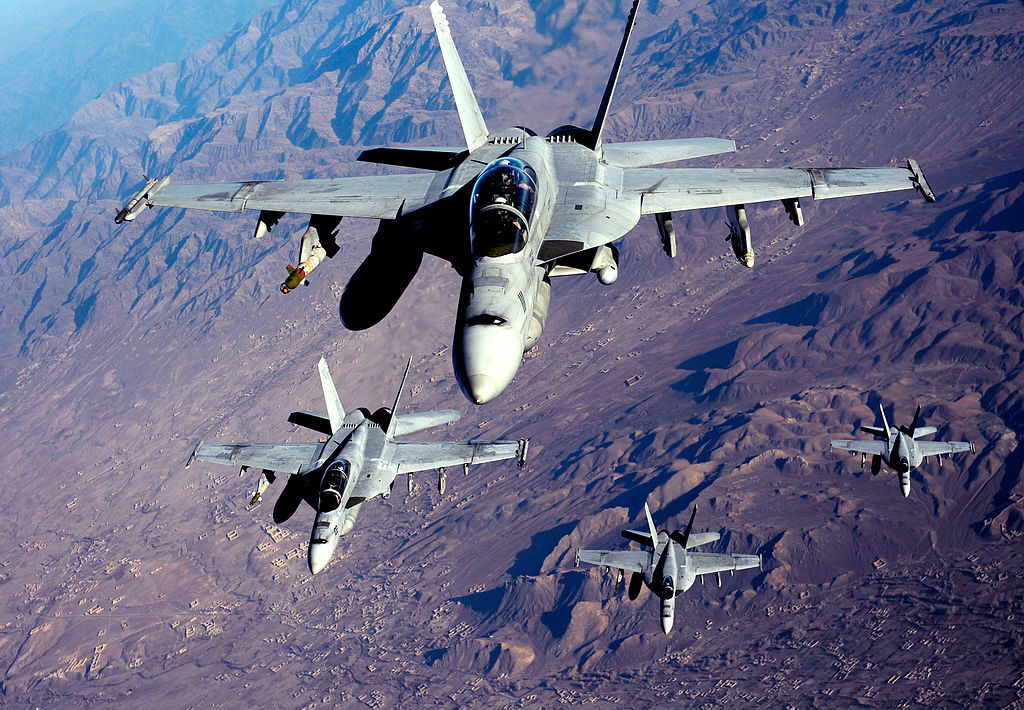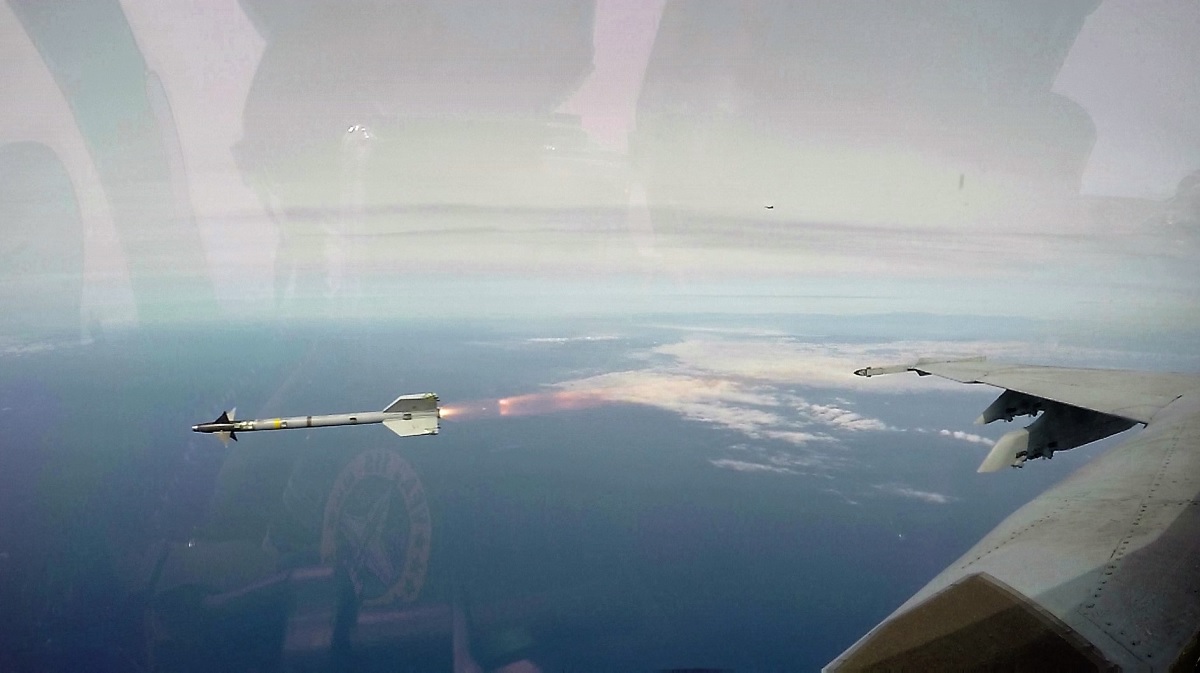As the Su-22 climbed after dropping ordnance, Tremel would respond, firing an AIM-9X Sidewinder missile that missed the Fitter. Then Tremel fired another missile, this time an AIM-120 AMRAAM, which shot down the Su-22
As we have previously reported, on July 30, 2017, LCDR Michael “MOB” Tremel, the F/A-18E Super Hornet U.S. Naval Aviator from VFA-87 Golden Warriors, shot down a Syrian Sukhoi Su-22 on June 18 and revealed some details of how he scored his kill during a short interview released to Save The Royal Navy.
But now, in a video first uncovered by The Drive, Tremel, along with the other three pilots who participated in the mission, offer a blow-by-blow account during a special panel at the Tailhook 2017 Symposium, held from September 7-10.
Here you can find the video where Tremel and the other Naval Aviators involved in the sortie describe the first air-to-air kill scored by a U.S. Navy aircraft since Operation Desert Storm (ODS).
Nevertheless, a full description of the engagement is also provided by an article that appeared on Military.com.
The pilots and their aircraft were assigned to Carrier Air Wing 8 (CVW 8)— embarked on the aircraft carrier USS George H.W. Bush (CVN-77). The carrier, which had been launching daily airstrikes from the Persian Gulf, had moved into the Mediterranean in early June, just days before the mission.
“Everyone’s kind of heading to the same place that day, to Raqqa. At that point in time, the [area of responsibility] was pretty hot in that general vicinity and a lot of guys were dropping bombs,” Tremel said.
The mission started out as just another close air support (CAS) sortie over Syria and there was even time en route for a cup of coffee: as Tremel said, both he and his wingman, VFA-87 training officer Lt. Cmdr. Jeff “Jo Jo” Krueger, enjoyed some java at 22,000 feet inbound to Raqqa.
“Again, we briefed CAS, and that was going to be our mission that day, so we felt like it would be in our wheelhouse, what we were doing,” Tremel explained. “But we also trained to all the air-to-air contingencies we might have and we talked about that.”
Once the aircraft arrived in the region coordinated with two other F/A-18 Hornet pilots, already above the area of operation. All four were communicating about events playing out on the ground far below.
“We’re hearing that the situation’s getting more heated on the ground with some of the friendly forces getting closer to some of the Syrian forces so, based on that, we get Jo Jo and MOB on the radio,” said Lt. Cmdr. William “Vieter” Vuillet, a pilot attached to VFA-37 Raging Bulls, another squadron embarked on the Bush.

As the pilots prepared to perform their CAS mission, someone spotted a Russian Flanker fighter aircraft circling overhead, which, according to the pilots, was not an unusual occurrence in the region.
Even though, as we have already reported, Tremel said that Russian pilots behaved with great professionalism during their previous encounters, he decided to follow the aircraft and monitor its actions as a cautionary measure since his Super Hornet previously experienced some minor technical issues.
“I’ll extend out in air-to-air master mode while these guys are in air-to-ground master mode to monitor the situation on the ground,” Tremel said. “That’s when I’ll pick up an unknown aircraft approaching from the south.”
Since observers, which included U.S. Air Force (USAF) assets in the region, were sending conflicting information about the identity of the aircraft, Tremel decided the best thing he could do was to get a visual ID on the aircraft and its activities, so he decided to descend and get a better look.
Eventually, a consensus emerged that it was a Syrian plane.
Meanwhile, Krueger worked to streamline radio communications, shedding secondary tasks and focusing on keeping information flowing as the situation unfolded.
After Tremel neared the Syrian aircraft, he said that he was ready to return to his primary job as soon as he could be sure it posed no danger to friendly forces.
“Our whole mission out there was to defeat ISIS, annihilate ISIS,” he said. “So as quickly as we can get back to that mission, that was our goal that day … At any point in time, if this had de-escalated, that would have been great. We would have gotten mission success and [gone] back to continue to drop bombs on ISIS.”

But that was not to happen; in fact, the Su-22 Fitter kept approaching friendly ground forces despite several radio warning calls from the Hornets that tried to persuade it to turn around.
At this point, as explained by Tremel, Krueger advised that the U.S. aircraft should execute “head-butts,” close overhead passes on the Syrian aircraft with warning flares.
They performed three such passes, but they did not affect the Syrian plane.
“After that third one, he [proceeded] to execute a dive and release ordnance in the proximity of friendly forces,” Tremel said.
According to Military.com, as the Su-22 climbed after dropping ordnance, Tremel would respond, firing an AIM-9X Sidewinder missile which missed the Fitter for reasons MOB didn’t explain.
“I lose the smoke trail and I have no idea what happened to the missile at that point in time,” he said.
Then Tremel fired another missile, this time an AIM-120 Advanced Medium-Range Air-to-Air Missile (AMRAAM), which shot down the Su-22.
“The aircraft will pitch right and down and the pilot will jump out and left in his ejection seat,” he said.

To stay clear of the debris field, Tremel executed a quick turn to the left, allowing the ejection seat to pass to the right of his canopy.
The pilots described the events in understated terms but acknowledged adrenaline was high as they returned to operations.
Vieter, who descended to get a visual following the air-to-air engagement, said he and the pilot flying with him, Lt. Stephen “Scotty P” Galecki, could not resist getting on a secure communication channel to tell the tanker crew what happened when they went to refuel.
Vieter and Gasecki opted to continue with their mission, while Tremel and Krueger soon decided to return to the ship.
According to Krueger, it was “no small feat” for Tremel to take the initiative to arm his aircraft and fire ordnance at an armed aircraft for the first time in two-and-a-half decades.
“Looking at the wreckage down below us, It was a different feeling,” Krueger said. “… We had to make some decisions pretty quickly, and I thought that the training and commander’s guidance that we got at that point was a big deal.”
As Tremel explained upon return to the ship, the fanfare was underwhelming; the sentiment was mere that “the show goes on.”
He shook a few hands on the flight deck, then was ushered away, the ordnance remaining on his aircraft quickly reloaded onto other fighters that would launch within the hour.

“It’s extremely surreal to be sitting here in this environment,” Tremel said. “I couldn’t have done it without the guy sitting next to me, Jo Jo, and the other guys that were airborne. It was an absolute team effort, to include all the coordination that went on with the Air Force the entire time we were in the AOR.”
Noteworthy since the decisions by Tremel and other U.S. pilots to fire at the Syrian Su-22 Fitter and at two drones in June, there haven’t been similarly provocative actions by pro-Syrian forces.
U.S. officials say Syrians seem to have understood the message.
However Tremel’s account confirms what was already stated about the air war in Syria by Lieutenant Colonel Jeremy Renken, the F-15E driver who shot down a “pro-Syria regime” Shahed 129 drone on Jun. 8 after the unmanned aerial vehicle (UAV) attacked U.S.-backed fighters in southern Syria.
For Renken in fact the Syrian conflict has evolved far beyond simply striking Islamic State targets on the ground.
“What this recent event has proven is that you can’t take for granted that you know what the fight is going to look like,” Renken said.

“You need to walk in ready for it to metastasize into any hybrid variation,” he pointed out.
Photo by Navy Lookout Twitter profile, Alan Wilson from Stilton, Peterborough, Cambs, the UK via Wikipedia, Radomil talk via Wikimedia Commons, Lt. Chris Pagenkopf, Specialist 2nd Class Sara B. Sexton / U.S. Navy and Staff Sgt. Andy M. Kin / U.S. Air Force

